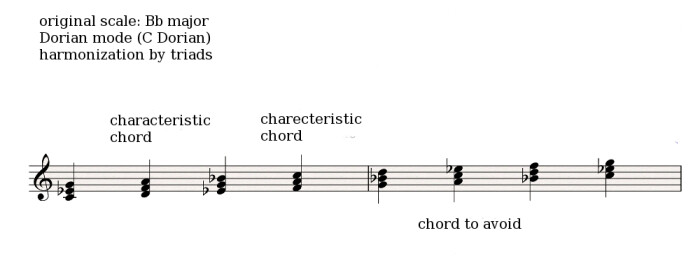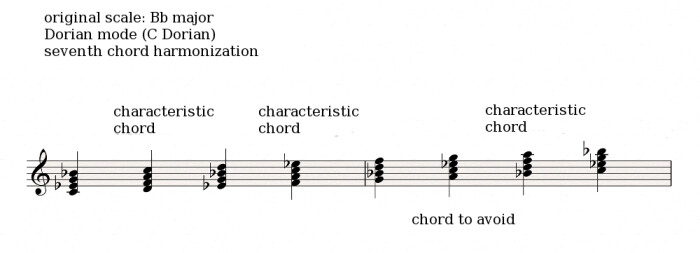In the previous articles we began to study the different means to identify modes. As we continue our way into the depths of modal harmony, today we'll start discovering the harmonic rules that determine these modes.

Foreword
Apart from the characteristic degrees we already mentioned, and which I allow myself to recall again for the sake of exhaustiveness, you will learn how to harmonize each of these modes in triads and seventh chords (as you already did with major and minor scales), how each node relates to a particular type of chord and, finally, which cadences you should use and avoid.
Before we begin, I want to point out again that when it comes to the harmonic functions of the chords in relation to their degree in each mode, you need to forget the notions of dominant, subdominant and their substitutes. In modal harmony you only speak about the tonic and characteristic chords.
Characteristic chords include the characteristic degree(s) of each mode. When harmonizing a tune within the modal framework, you should try to avoid certain chords, namely all that include the diminished fifth (b5), due to their high instability. These are the only occasions where the tritone is forbidden in modal harmony. However, dominant 7th chords aren’t, as long as they don’t result in a perfect cadence with the following chord. And the tritone may also be put to use within the framework of the modal fragment (see article 48), the latter being paramount to the instability of the tritone to affirm the modal character.
Now that we’ve got that out of the way, let’s begin!
The Ionian mode



The Ionian mode is the one that starts from the first degree of the scale. It’s associated to a major chord: I major of the original scale. Its characteristic degrees are the fourth and the seventh. It’s the only natural mode that has two NCDs. In fact all its chords apart from the tonic chord and the V degree are considered characteristic because they all include one of these two notes. As for the rest, the Ionian mode is nothing more than the major mode of the tonal system, which we have explored at length throughout this series (see article 4 for its harmonization). So it would be useless to linger too long on the topic, although there is one detail that’s worth mentioning:
In article 48 you saw that one of the Ionian’s mode characteristic notes is its fourth degree. Yet, as you also saw in article 23, the perfect fourth is considered a mixed consonance, which makes it hard to fit into a tonal environment. However, using this interval in a musical passage will have the tendency to emphasize its modal (an hence non-tonal) aspect.
The Dorian mode



The Dorian mode is the one that starts from the second degree of the scale. It’s associated to a minor chord: II minor of the original scale. Its natural characteristic degree is the VI degree. Its characteristic chords are those of degrees II, IV and VI, which should be avoided. And you should avoid the cadence going from the IV degree (IV7 in this case) into the VII degree (VII M7), because it results in a perfect cadence. And this not only means that the latter will become the new tonic but you will also depart from the modal system.






